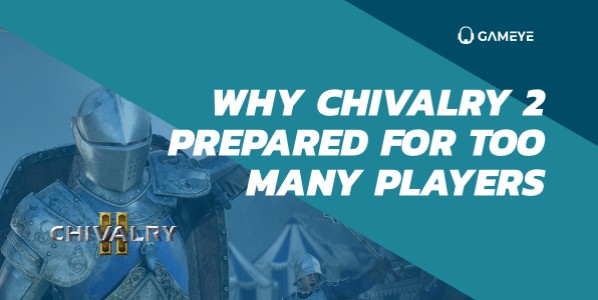This article was created in collaboration with Gameye, and written by Gameye co-founder Sebastiaan Heijne.
As a die hard Rust player, I have always had a passion for multiplayer games and their technology. I co-founded Gameye after I had experimented with containerizing a CS-GO server just for kicks. Gameye evolved into a technology company specializing in automated capacity management for multiplayer games.
And now, we recently partnered with Tripwire and Torn Banner for Chivalry 2, and I wanted to share everything we learned from this project with you.
People will often give advice on how to mitigate risk and failure, but less frequent is the advice on how to prepare for – or how to cope with – more success than anticipated. For a multiplayer game, that success is about how many players you can get to play (and enjoy) your game. And how to host a surge in players with minimal downtime, issues or frustration. The multiplayer experience has to be seamless or players might not come back. Especially with a new release.
Let’s look at some of the data in what we did with Chivalry 2. Gameye provided the server capacity to help serve 250,000 players at launch, and up to around a million in the first month. (They’ve sold over a million copies worldwide, and so far 420 million knights have been slain since launch.)
This was an unexpected success. Yes, all of the predictions looked good based on how many pre-orders we had, but we ended up with twice as many players at launch as the best case models projected.
So, how did we prepare for the launch of Chivalry 2, which saw double the expected number of players? And how do you deal with these unexpected surges?
#1: Use your community to stress test
You never know what’s going to happen. We worked with Torn Banner and Tripwire for around 15 months on regular closed alpha tests. We used these tests to engage our community, find and squash bugs, and optimize our systems.
And if it wasn’t for the reports from the Chivalry 2 community on Discord during these tests, we wouldn’t have found a performance issue that would’ve severely impacted the player experience. We quickly found a fix and worked closely with Tripwire and Torn Banner to roll out the solution and begin testing. And then we tested again to make sure.
There will always be bugs while testing; it’s inevitable. It’s about working with your community, and giving yourself enough time to find those bugs and fix them. So stress-test your multiplayer environment early. What happens if your game goes viral in Japan? Can your provider spin up capacity in time?
#2: Expect to be wrong
Before the Chivalry 2 open beta, we saw the demand rising significantly for the game, so as a precaution we increased our capacity and prepared for a potential launch day rush. This meant we had to rejig our global reach to prepare for more players. The benefit to being platform agnostic is the ability to choose the best providers around the world and add capacity easily.
When you’re launching a game, there are so many moving parts that – inevitably – things will change. Maybe it’s a model, maybe it’s a pandemic shutting down part of your studio. Whatever it is, expect some things to go wrong, put some ‘what if’ plans in place, be quick to act, and make sure your systems can cope with sudden changes.
#3: Balance the cost
Traditionally, a surge of players means you’re going to pay more than you expected. That’s usually the real dilemma with success: it costs. And this can really hurt your bottom line on whether your game is profitable.
So make sure you check how your provider charges. Do they include traffic or egress charges? What happens when you need more resources? What if you need to add another country? What are the cut-off points? Can you afford the extra load if your game gathers momentum?
#4: Don’t be afraid to find fans around the world
This was a big lesson. We worked with Tripwire and Torn Banner to enable playable locations outside of North America and Europe where they could increase their reach to new players, outside of their normal audiences, which proved to be a good idea. Chivalry 2 excited players across the world and places like Japan and Korea saw a lot of interest, which meant we added capacity and managed the surge more effectively.
We sidestep these worries
With Chivalry 2, our infrastructure handled twice the number of players with zero downtime, at a considerably lower cost than a traditional approach. It also meant Chivalry 2 could launch worldwide. In fact, it was able to launch in Japan and Korea with low latency, without any risk to the game or the bottom line.
This is down to how Gameye manages capacity. We know it can be unpredictable, so our system looks at the demand and automatically allocates resources where it is needed. You don’t need to guess or worry about inflated costs, because it runs your sessions automatically and keeps the costs predictable.
But we understand that new technology is always a risk. And we’re glad that Chivalry 2 decided to take that risk. So we hope that at least you’ll know what to check when you’re looking for a server provider.
If you’d like to learn more, you can read our case study on the launch.

 MCV/DEVELOP News, events, research and jobs from the games industry
MCV/DEVELOP News, events, research and jobs from the games industry




